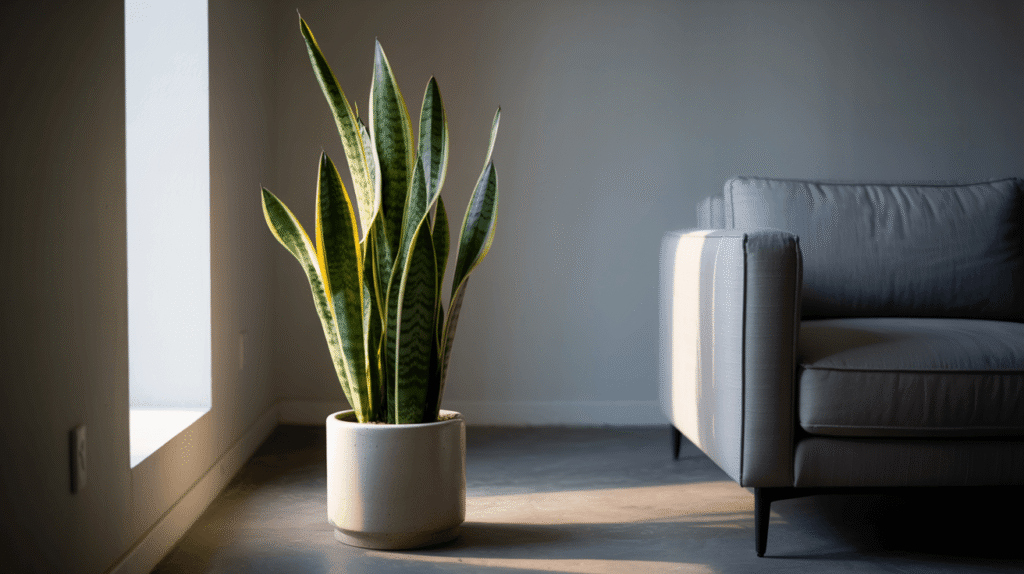If you’ve ever tried decorating a dimly lit living room, bedroom, or office corner, you know the struggle—plants usually need sunlight to survive. But here’s the good news: there are plenty of indoor plants that thrive in dark rooms.
Whether you live in a cozy apartment with limited windows, have a north-facing room that hardly gets sunshine, or simply want to brighten up that shadowy corner of your home, there are low-light indoor plants that can survive—and even thrive—without direct sunlight.
These plants don’t just look beautiful; they also purify the air, reduce stress, and add life to otherwise dull spaces. In this guide, we’ll cover the best plants for dark rooms, expert care tips, styling ideas, and everything you need to know to keep your green friends happy in low-light conditions.
Why Choose Indoor Plants for Dark Rooms?
Not every room in your home has the luxury of large, sunny windows. But that shouldn’t stop you from enjoying the benefits of greenery. Here’s why dark room plants are the perfect solution:
🌿 They Purify the Air
Even in shaded spaces, plants like peace lilies and snake plants work hard to clean toxins from the air.
🌱 They Thrive in Low Maintenance Conditions
Most low-light plants are resilient, requiring minimal care—ideal for beginners.
🌑 They Brighten Gloomy Corners
Green leaves and unique shapes bring life to otherwise forgotten areas.
🛋️ They Enhance Interior Design
From bedrooms to offices, plants make every room feel cozy and inviting.
The Best Indoor Plants for Dark Rooms
Let’s dive into the top 15 indoor plants that love shade and low light.
🌑 1. Snake Plant (Sansevieria)
- Why it’s perfect: One of the toughest plants you can own, it thrives on neglect.
- Light needs: Survives in dark corners and even artificial light.
- Care tip: Water only when the soil is completely dry.
🌑 2. ZZ Plant (Zamioculcas zamiifolia)
- Why it’s perfect: Glossy leaves that brighten any space.
- Light needs: Tolerates almost no natural light.
- Care tip: Very drought-tolerant—water once every 2–3 weeks.
🌑 3. Peace Lily (Spathiphyllum)
- Why it’s perfect: Known for elegant white blooms in low light.
- Light needs: Thrives in shade and artificial lighting.
- Care tip: Keep soil consistently moist and mist leaves occasionally.
🌑 4. Cast Iron Plant (Aspidistra elatior)
- Why it’s perfect: Nicknamed “cast iron” because it’s almost indestructible.
- Light needs: Perfect for dark bedrooms and offices.
- Care tip: Tolerates neglect, just avoid overwatering.
🌑 5. Pothos (Devil’s Ivy)
- Why it’s perfect: Beautiful trailing plant with heart-shaped leaves.
- Light needs: Grows in low-light hallways and shaded rooms.
- Care tip: Trim regularly to encourage fuller growth.
🌑 6. Philodendron
- Why it’s perfect: A classic houseplant with lush green leaves.
- Light needs: Excellent for indirect or artificial light.
- Care tip: Allow the top inch of soil to dry before watering.
🌑 7. Parlor Palm (Chamaedorea elegans)
- Why it’s perfect: A tropical touch for dim spaces.
- Light needs: Grows well in shaded rooms.
- Care tip: Mist regularly to maintain humidity.
🌑 8. Chinese Evergreen (Aglaonema)
- Why it’s perfect: Striking leaves with silver and green patterns.
- Light needs: Thrives in low-light conditions.
- Care tip: Fertilize monthly during the growing season.
🌑 9. Ferns (Boston Fern, Maidenhair Fern)
- Why it’s perfect: Add soft, feathery texture to dark corners.
- Light needs: Prefer shade and high humidity.
- Care tip: Mist daily or place near a humidifier.
🌑 10. Lucky Bamboo
- Why it’s perfect: Considered a symbol of good luck and positivity.
- Light needs: Grows well in low light, even in water-filled containers.
- Care tip: Change water every 2–3 weeks.
🌑 11. Dracaena
- Why it’s perfect: Sleek, modern look with long green leaves.
- Light needs: Handles shade and filtered light.
- Care tip: Wipe leaves to prevent dust buildup.
🌑 12. Spider Plant (Chlorophytum comosum)
- Why it’s perfect: Air-purifying and easy to grow.
- Light needs: Adapts to low light but prefers indirect light.
- Care tip: Trim baby shoots to keep it compact.
🌑 13. Calathea
- Why it’s perfect: Bold patterned leaves that fold up at night.
- Light needs: Prefers shade and humidity.
- Care tip: Keep soil moist and avoid direct sunlight.
🌑 14. Monstera (Swiss Cheese Plant)
- Why it’s perfect: Iconic split leaves bring tropical vibes indoors.
- Light needs: Grows surprisingly well in shaded rooms.
- Care tip: Needs occasional pruning to control size.
🌑 15. Rubber Plant (Ficus elastica)
- Why it’s perfect: Shiny, dark green leaves make a bold statement.
- Light needs: Tolerates low light but prefers indirect light.
- Care tip: Water weekly and clean leaves regularly.
How to Care for Indoor Plants in Dark Rooms
Even though these plants love shade, they still need proper care. Here’s how to make them thrive:
🌱 1. Choose the Right Plant for the Space
Match plant type to your room’s conditions—bedroom, bathroom, office, or hallway.
💡 2. Supplement with Artificial Light
- Use LED grow lights if your space has no windows.
- Position lights 6–12 inches above plants.
💧 3. Water Wisely
- Dark rooms stay cooler, so soil dries slower.
- Check moisture levels before watering to avoid root rot.
🌿 4. Humidity Management
- Bathrooms are naturally humid (perfect for ferns).
- Use trays of water or humidifiers in drier rooms.
🌸 5. Fertilize Sparingly
- Low-light plants grow slower, so monthly feeding is enough.
Styling Ideas: Making the Most of Dark Room Plants
Indoor plants aren’t just about survival—they’re about design. Try these creative ideas:
- Trailing Plants on Shelves: Pothos and philodendrons add elegance to bookshelves.
- Statement Floor Plants: Rubber plants and monstera transform gloomy corners.
- Mini Jungle Bathrooms: Fill with ferns and calatheas for a spa-like vibe.
- Desk Companions: Snake plants and ZZ plants thrive under office lighting.
Common Mistakes to Avoid
- Overwatering: The #1 killer of low-light plants.
- Placing in Total Darkness: Plants still need some indirect or artificial light.
- Neglecting Dust: Dust blocks limited light—wipe leaves regularly.
- Crowding Plants: Low airflow increases risk of pests and disease.
Frequently Asked Questions (FAQ)
1. Can plants really survive in dark rooms?
Yes, many plants like ZZ plants, snake plants, and peace lilies thrive in low-light spaces.
2. What’s the best plant for a windowless room?
The ZZ plant and snake plant are excellent choices because they tolerate artificial light.
3. Do dark room plants grow slower?
Yes, low-light conditions slow growth, but the plants stay healthy with proper care.
4. How do I add light for plants in a dark room?
Use LED grow lights or place plants near reflective surfaces like mirrors.
5. Which low-light plants are safe for pets?
Spider plants and parlor palms are pet-safe, but avoid lilies, pothos, and philodendron.
Conclusion: Brighten Your Dark Rooms with Greenery
Dark rooms don’t have to feel dull or lifeless. With the right selection of low-light indoor plants, you can create a lush, vibrant space that feels fresh and inviting. From the hardy snake plant to the elegant peace lily, these green companions not only survive in shade but actually thrive there.
So don’t let lack of sunlight stop you—transform your dim spaces into cozy indoor jungles today.
🌿 Ready to explore more plant care guides and styling tips? Visit Green Plant Zone for expert advice on choosing, growing, and styling plants for every corner of your home.

Hi, I’m the creator of Green Plant Zone, a space dedicated to plant lovers. I share tips on indoor and outdoor gardening, plant care guides, and eco-friendly living. My mission is to help you grow healthier, happier plants and bring more greenery into everyday life.
